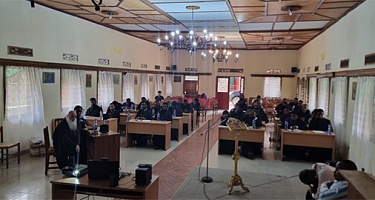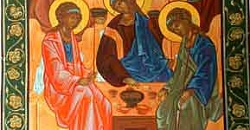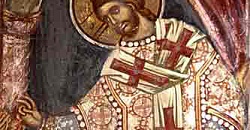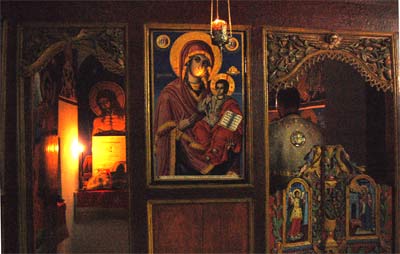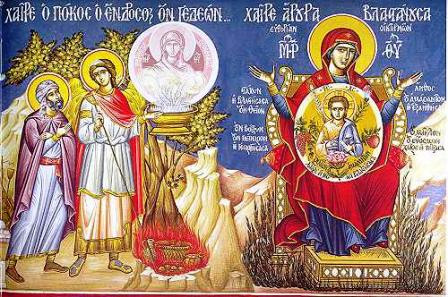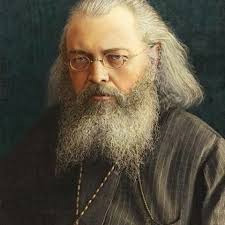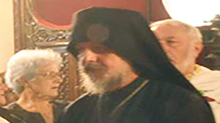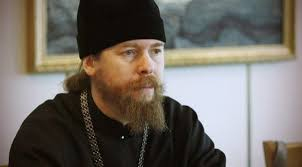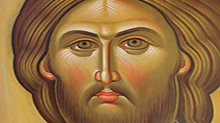Прашање од: Мирјана Лампева
Кои се каноните на Православната Црква за канонизирање светец? Ви благодарам.
Одговор:
Почитувана Мирјана,
Еве го одговорот:
Eastern Orthodox Practice—Glorification
Tsar Alexis praying before the relics of Metropolitan Philip.Within the Eastern Orthodox Church, the canonization—or, more properly from the
Orthodox perspective, the "Glorification"—of saints differs from the western tradition in both theology and practice. The Glorification of saints is
considered to be an act of God, not an act of the Church Militant. The official recognition of saints grows from the consensus of the church.
When an individual who has been sanctified by the grace of the Holy Spirit falls asleep in the Lord, God may or may not choose to glorify the
individual through the manifestation of miracles. If He does, the devotion to the saint will normally grow from the "grass roots" level. Eventually, as
the Holy Spirit manifests more miracles, the devotion to the individual grows. At this point there are no formal prayers by the Church to the
individual. Rather, memorial services (Greek: Parastas, Russian: Panikhida) are served at the grave of the individual, praying for him or her—though an individual may pray privately to someone who has not yet been formally Glorified, and even commission Icons, which may be kept in the home but not displayed in the Temple (church building).
Eventually, the evidence of their saintliness will have grown to such a degree that a formal Service of Glorification will be scheduled. A Glorification may be performed by any Bishop within his Diocese, though such services are usually performed under the auspices of a Synod of Bishops.
Often there will be a formal investigation to be sure that the individual is Orthodox in their faith, has led a life worthy of emulation, and that the
reports of miracles attributed to their intercessions are verifiable. The Glorification service does not "make" the individual a saint; rather, the
Church is simply making a formal acknowledgement of what God has already manifested.
The incorrupt Relics of St. John (Maximovitch) at the time of his Glorification in San FranciscoSometimes, one of the signs of sanctification
is the condition of the Relics of the Saint. Some saints will be incorrupt, meaning that their remains do not decay in conditions when they normally
would (natural mummification is not the same thing as incorruption).Sometimes even when the flesh does decay the bones themselves will manifest
signs of sanctity. They may be honey colored or give off a sweet aroma. Some relics will exude myrrh. The absence of such manifestations is not
necessarily a sign that the person is not a Saint.
In some traditions, an individual who is being considered for Glorification ill be referred to as "Blessed," though there is no formal service of
"beatification" in the Orthodox Church. It should be noted that some ully-glorified saints are also referred to as "Blessed," such as a Holy
Fool for Christ (for instance, "Blessed St. Xenia") or saints who have been iven this particular appellation (such as, "Blessed Augustine", "Blessed
Jerome", and others). In such cases the title "Blessed" is in no way ntended to imply that they are less than fully saints of the Church.
The particulars of the Service of Glorification may differ from jurisdiction o jurisdiction, but normally it involves the formal inscribing of the
individual's name into the Calendar of Saints (assigning a special day of he year on which their feast is to be celebrated), the chanting of a
service in honor of the Saint (normally using specially commissioned hymns hich are chanted for the first time at the Glorification) and the unveiling
of an Icon of the new Saint. Before the Glorification itself there may be a pecial "Last Panikhida," a solemn Requiem at which, for the last time, the
Church prays for the repose of their soul. After the Glorification, the hurch will no longer serve a Panikhida for the repose of his soul, but
instead a Paraklesis or Moleben will be served to implore their ntercessions before the Throne of God.
Martyrs need no formal Glorification. The witness of their self-sacrifice is ufficient (provided their martyrdom was the result of their faith, and
there being no evidence of un-Christian behaviour on their part at the time f their death). Not all saints are known, many will remain hidden by God
until the Second Coming of Christ. For this reason, on the Sunday after entecost the Orthodox celebrate all the righteous souls together on All
Saints Sunday. In some jurisdictions, the Sunday following All Saints Sunday ill be a day of general commemoration of all saints (known and unknown) of
the local church. For instance, All Saints of the Holy Mountain, All Saints f Russia, All Saints of America, etc.
St. Symeon the New Theologian writes: "The saints in each generation, joined o those who have gone before, and filled like them with light, become a
golden chain, in which each saint is a separate link, united to the next by aith, works, and love. So in the One God they form a single chain which
cannot quickly be broken."








